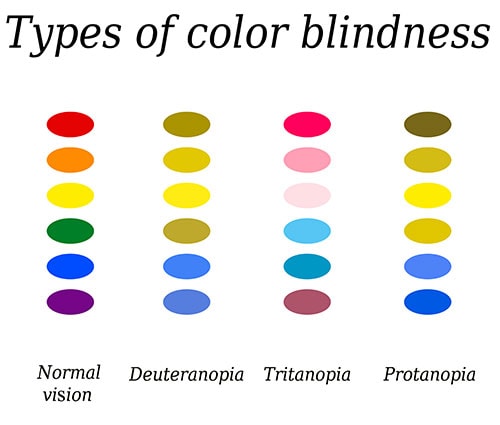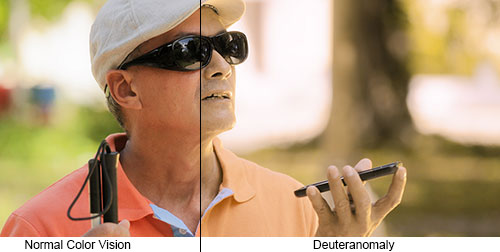
Color blindness (or colour blindness for our readers across the pond) is often misunderstood by those who don’t have it. We think of movie depictions of dogs, seeing only in black, white, and gray. But color blindness (in humans and in dogs) is actually much more complicated than that.
Today we’ll be going over the types of color blindness, their causes, and what treatment options exist.
What is color blindness?
To understand color blindness, we must first understand how the eye works. Light enters through the front (lens) of your eye and is focused onto the retina (back of the eye). The retina is composed of special nerve cells (photoreceptors) containing pigments that react to light. These are your rods and cones.
Rods aren’t related to your color vision; they react the same way to all colors of light. Rods are actually very light-sensitive and contribute to our night vision!
Cones are what we need to focus on today. There are three types of cone cells and these control your color vision. The pigments in these cone cells react to different wavelengths of light:
- short wavelengths (blue)
- medium wavelengths (green)
- long wavelengths (red)
Color blindness occurs when the pigments in your cone cells don’t respond properly (or at all).
What are the different types of color blindness?
Color blindness is also known as “color vision deficiency.” This is because color blindness is caused by a deficiency in your eye’s cone cells.
About 60% of your cones are red-sensitive, about 30% are green, and less than 10% are blue. So, the type of color blindness a patient experiences will depend on which cone cells are affected: red, green, or blue.
Red-Green Color Blind
The most well-known form of color deficiency is red-green color blindness; it occurs when there’s a problem with your red or green cones.

Red-green color blindness is the most common form of color blindness, affecting 8% of men and 0.5% of women.
Because your red cones and green cones can malfunction separately, there are actually multiple types of red-green color blindness.
Deuteranomaly
The most common type of color blindness, this form affects 5% of men. Also called deutan color blindness, it occurs when the green cones don’t work correctly. As a result, yellow and green look redder, and blue is hard to differentiate from violet.
Protanomaly
In protan color blindness, red cones don’t work correctly. This type of color blindness is usually mild. Orange, red, and yellow look greener, and colors are less bright overall.
Protanopia
Your red cone cells just don’t work at all. Red just looks gray and orange, yellow, and green looks yellow.
Deuteranopia
The green cone cells don’t work at all. Greens look beige and reds look brownish-yellow.
Blue-Yellow Color Blind
Tritan color blindness only affects 1 in 10,000 people and (unlike red-green) affects men and women equally. While it can be inherited, blue-yellow color blindness is more likely to be acquired later in life due to glaucoma, cataracts, age-related macular degeneration, retinopathy, or other eye diseases that affect your optic nerve or retina.
There are two varieties of blue-yellow color blindness.
Tritanomaly
In this type of color blindness, the blue cones have a change in color sensitivity. Tritan color blind people tend to confuse blue and green, as well as yellow, orange, and red.
Tritanopia
The blue cones don’t work at all.
Complete Color Blindness
The previously listed forms of color blindness are “anomalous trichromacy” or “dichromacy.” That is, still having all three color rods, but with some malfunction or only having two color rods functioning.
There are, however, more advanced forms of color blindness, such as:
Cone Monochromacy
This occurs when two of the three cone cell pigments don’t work.
Achromatopsia
A total lack of color vision. People with complete achromatopsia only see in shades of black, white, and gray and often experience other vision problems as well.
How to tell if you’re color blind
The symptoms of color blindness depend on the severity of the color blindness. Some people have such mild symptoms they aren’t even aware they have a deficiency in their color perception.
For the most part, color blindness does not affect the sharpness of vision. Primary symptoms of color blindness include:
- trouble seeing colors or brightness of colors
- inability to tell the difference between shades of the same or similar colors (most commonly with red and green or blue and yellow)
If you suspect you might be color blind, talk to your eye doctor about a color vision test.

How is color blindness diagnosed?
Generally, children may take a color blind test as part of a regular eye exam, especially if they are at risk of color blindness.
Even if you’ve never taken a color vision test, you’ve probably seen images from the Ishihara color test.
Patients with normal color vision are able to make out the numbers hidden in these fields of colored dots. Color blind people will either be unable to see the numbers or (depending on the image) see a different number. This allows the eye doctor to detect the type and severity of a patient’s color blindness.
What are the causes of color blindness?
You may have heard that color blindness is genetic. It is a recessive X-linked gene, meaning it’s carried on the X chromosome and passed down through families.
Most color blind people are born with the condition. However, it can develop later in life due to health problems. Some non-genetic causes of color blindness include:
- eye diseases
- diabetes
- Alzheimer’s disease
- Parkinson’s disease
- multiple sclerosis
- chronic alcoholism
- leukemia
- use of certain drugs, including: hydroxychloroquine
Why color blindness is more common in males
If you remember high school biology, you probably remember that (generally) people either have XX chromosomes or XY chromosomes. Because the gene that causes color blindness is carried on the X chromosome, people with two X chromosomes are more likely to be carriers of the gene without having symptoms.
This is because color blindness is recessive, so you’d have to have the color blind gene on both X chromosomes to actually be color blind; otherwise, the dominant normal color vision gene overwrites the color blind gene.
However, most men only have one X chromosome, meaning they only need one color blind gene to be color blind.
Interestingly, a 2014 study showed that color blindness is also more common in white people. Published in the American Academy of Ophthalmology (AAO) Ophthalmology journal, the study looked at color vision deficiency in preschool-aged children. They found that while 6% of white boys had color blindness, color blindness only affected 3% of Asian American and Latino boys and only 2% of African American boys.
Can color blindness be cured?
There is no cure for genetic color blindness. However, there are ways to mitigate its impact on your day-to-day life.
Many important items in life (traffic lights, stop signs) have workarounds for color blind people. If you can’t tell the difference between red and green, traffic lights are always in the same order (red light on top, green light on the bottom). Yes, stop signs are red, but they’re also all the same distinct shape.
For “less important” color distinctions (do these clothes match? which of these pens is red?) there are smartphone apps that can identify colors.
There has also been a boom in recent years in color blind glasses and contact lenses. The National Eye Institute has even published research into the functionality of color blind glasses. While these devices won’t cure your color blindness, they can help recognize the difference between colors (depending on the severity of your color blindness).
If you developed color blindness later in life due to disease, treating or managing the disease can help resolve your color vision deficiency.
How color blind people see
If you have normal color vision, it can be hard to envision what color blindness is like. Through the magic of technology, we have color blindness simulators!
Whether you’re a designer trying to make your site or product usable for color blind customers or just curious, websites and browser plug-ins can simulate what the world looks like with color blindness.

Choose Assil Gaur Eye Institute for your Vision Care
At AGEI, you will experience state-of-the-art ophthalmology that brings revolutionary technologies together with experienced, board-certified vision care professionals. Our goal is to help you achieve your best possible vision and eye health. Contact us for a consultation.
Please call 866-945-2745 or visit us here to make an appointment online with our eye doctors. If you are experiencing any concerning symptoms or require immediate eye care, contact us immediately to determine the best time to schedule an exam.
Assil Gaur Eye Institute takes our patients’ safety seriously. Our facility’s Covid-19 patient safety procedures exceed all the CDC’s coronavirus pandemic recommendations. Masks are always required in our institutes.
We are conveniently located for patients throughout Southern California and the Los Angeles area at locations in or near Beverly Hills, Santa Monica, West Los Angeles, West Hollywood, Culver City, Hollywood, Venice, Marina del Rey, Malibu, Manhattan Beach, and Downtown Los Angeles.
- What’s New in Keratoconus Treatment? A 2024 Update - 04/16/2024
- Dr. Assil and His Team Correct the Side Effects of Laser Eye Surgery - 04/03/2024
- What is ocular herpes? - 09/22/2023













